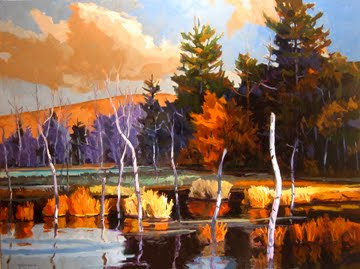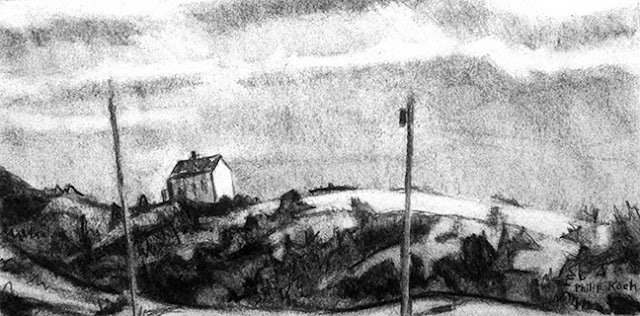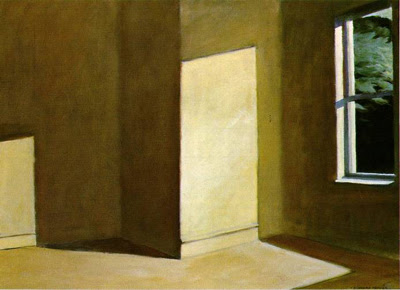The Great Tree of Art
Philip Koch, Inland, oil on canvas, 45 x 60", 2008
One of the lessons that came from my early teachers was seeing painting as a flat surface like a wall that you would then decorate by breaking it up into colored pieces. Even later as I came to focus more on building deep spaces and atmosphere, you can still feel in my work the brushstrokes as individuals who delight in doing their little dance up on the surface of the painting. Maybe one never completely outgrows one's early teachers. There's a side of me that's a crypto-modern artist.
In many ways it helps to envision the art world as a great tree with many branches. In the previous post, My Early Years As an Artist, I talked about my long route from a beginner in 1966 to my Master of Fine Arts program at Indiana University. Pretty much every artist I met along the way had a similar university oriented background. You could say we were all sitting together on the same big branch. I didn't know much about the rest of the tree.
Elizabeth Ives Hunter, the Director of the Cape Cod Museum of Art has a long personal history with another thread that runs through the American painting world. Her godfather was the conservative Boston painter R.H. Ives Gammell. In the summer of 2007 she organized a conference on realist paintings aimed at contrasting views of realism. She invited as panelists a few painters like myself and a few others who came out of the other branch of the tree. It's called the classical realist tradition by some or the academic tradition by others. So I was fascinated to meet a few of these painters from "the other side." Generally they seemed quite happy perching on their branch of the great art tree.
One of the other speakers was the landscape painter Stapleton Kearns. I liked his work and what he has to say. Some time later I discovered his blog and fell into the habit of reading it. He writes a lot about his own history and in particular about how he learned to do his kind of painting. One of his all time favorite painters was also one of mine, the 19th century American landscape painter George Inness. He writes about people like that and others from the Hudson River School tradition I find so intriguing. His research has turned up all sorts of weird and arcane facts and trivia about the old painters you're not likely find anyplace else. He also has an absolutely wicked sense of humor that breaks through his serious writing (a lot).
Kearns wrote a great series of post detailing his sometimes erratic course of learning to become a painter. He was one of a handful of students who studied privately with the same
R.H. Gammell fellow I mentioned earlier. He did this for something like three years. It was a very structured and hierarchical scene. The sort of training he received was so different than mine it blew my mind to read about it. Yet obviously from it he gleaned much.
Gammell, in turn, had studied with a now very well appreciated earlier Boston painter, William Paxton. Below is one of Paxton's oils. It's a vivid, complex, and deeply emotive painting. Paxton was influenced by French impresionism, but just as much the hand of Vermeer from the 17th century can be felt. Looking at it now, I think it has at least the formal complexity of the best Frank Stella painting, and to be honest, a great deal more. I wish some of my teachers had been Paxton enthusiasts.
From all this I conclude you can come to painting from a lot of different places. I never heard of Paxton when I was a student as all the buzz tended to revolve around the giants of modernism and surrealism (a favorite of a few of my teachers). We never got around to exploring the cultural backwaters of the painting world. That came later and I found there was much to be found in the more traditional 20th century painters.
Here are a few of Stapleton Kearn's landscapes.

I confess one of the things I like about Kearns is he likes a lot of the same kinds of sources to paint from as I do. The work above looks like a place I'd like to paint. In this piece one of the great pleasures is the subtle way Stapelton make the water's surface just a touch more rough than the pearly sky. So often twilight is just like that.
This river in the snow painting has a cast of thousands when it comes to trunks and branches. You literally can't paint them all. I like very much the way the artist picks and chooses just a few trees to cast in starring roles and blends the rest into a series of colored hazy greys. It feels like the whole forest is there but that is as much by artifice as anything.
And here's a great essay in paint on creating a sense of atmosphere through carefully changing the edge quality of the forms from that of crisp potato chips up front to soft feathers in the background. There's also an expansive range of intensities in his oranges and yellows. Those two hues are very easy to overdo, and the artist's restraint gives the painting some of its sober power.
From my perch in the tree of art, I think my education was strongly biased toward self-education. My teachers influenced me of course, but they had a tremendous reluctance to impose their values on me across the board. In the way it forced me to look at my own heart as the ultimate guide through the jungle of contemporary art. As a cost for this freedom, there was an awful lot of silly and even ridiculous art going on in the painting classes I took. Often there was a dreadful lack of self discipline and active looking that held the students back from achieving what they were trying to do. Also there was a terror of getting stuck somehow in influence from the past that strikes me now as a little paranoid.
Looking over at the kind of instruction an artist like Stapleton received, there was discipline aplenty, and a much more focused range of tasks presented to the student. Practice at sharp observation and romance with the art of the past were obviously right up there on the front burner. Nothing is without dangers, and this kind of a beginning sometimes can ensnare an artist in an almost too reverential embrace of the old masters' vision. Yet other artists can come out of such an an engagement with the art of the past enlivened and fully armed, ready to do something fresh.
I don't think there are easy answers for how to train young artists. I don't feel completely comfortable on any of the trees branches. But at least I'm glad they're all there.






